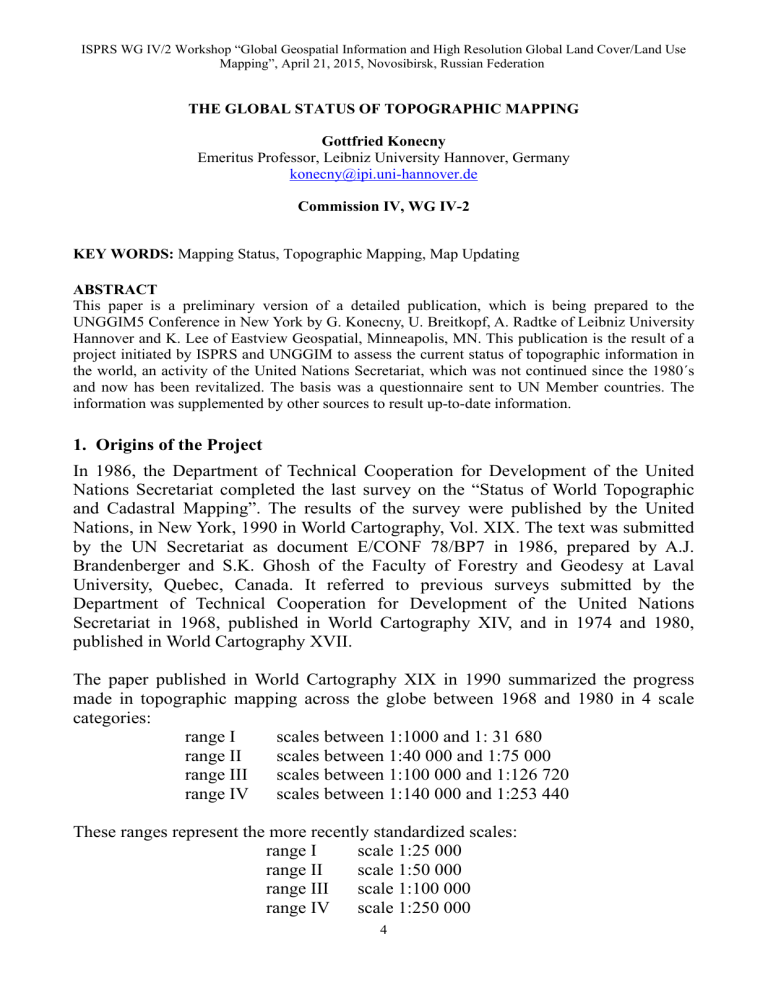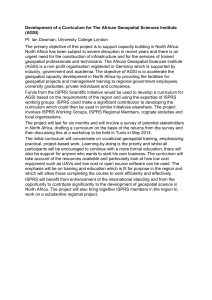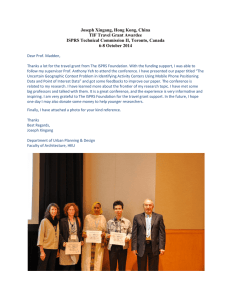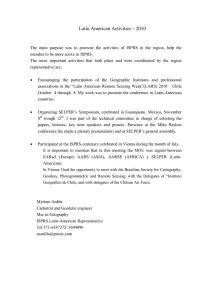Document 11840987

ISPRS WG IV/2 Workshop “Global Geospatial Information and High Resolution Global Land Cover/Land Use
Mapping”, April 21, 2015, Novosibirsk, Russian Federation
THE GLOBAL STATUS OF TOPOGRAPHIC MAPPING
Gottfried Konecny
Emeritus Professor, Leibniz University Hannover, Germany konecny@ipi.uni-hannover.de
Commission IV, WG IV-2
KEY WORDS: Mapping Status, Topographic Mapping, Map Updating
ABSTRACT
This paper is a preliminary version of a detailed publication, which is being prepared to the
UNGGIM5 Conference in New York by G. Konecny, U. Breitkopf, A. Radtke of Leibniz University
Hannover and K. Lee of Eastview Geospatial, Minneapolis, MN. This publication is the result of a project initiated by ISPRS and UNGGIM to assess the current status of topographic information in the world, an activity of the United Nations Secretariat, which was not continued since the 1980´s and now has been revitalized. The basis was a questionnaire sent to UN Member countries. The information was supplemented by other sources to result up-to-date information.
1.
Origins of the Project
In 1986, the Department of Technical Cooperation for Development of the United
Nations Secretariat completed the last survey on the “Status of World Topographic and Cadastral Mapping”. The results of the survey were published by the United
Nations, in New York, 1990 in World Cartography, Vol. XIX. The text was submitted by the UN Secretariat as document E/CONF 78/BP7 in 1986, prepared by A.J.
Brandenberger and S.K. Ghosh of the Faculty of Forestry and Geodesy at Laval
University, Quebec, Canada. It referred to previous surveys submitted by the
Department of Technical Cooperation for Development of the United Nations
Secretariat in 1968, published in World Cartography XIV, and in 1974 and 1980, published in World Cartography XVII.
The paper published in World Cartography XIX in 1990 summarized the progress made in topographic mapping across the globe between 1968 and 1980 in 4 scale categories: range I scales between 1:1000 and 1: 31 680 range II scales between 1:40 000 and 1:75 000 range III scales between 1:100 000 and 1:126 720 range IV scales between 1:140 000 and 1:253 440
These ranges represent the more recently standardized scales: range I scale 1:25 000 range II scale 1:50 000 range III scale 1:100 000 range IV scale 1:250 000
4
ISPRS WG IV/2 Workshop “Global Geospatial Information and High Resolution Global Land Cover/Land Use
Mapping”, April 21, 2015, Novosibirsk, Russian Federation
While scale in the age of digital cartography has changed the meaning, the scale ranges nevertheless maintain their significance with respect to the resolution of mappable details.
The 1986 survey covered the following number of countries or territories:
Africa
North America
South America
Europe
Asia
USSR
Oceania
53 countries
24 countries
12 countries
39 countries
40 countries
1 country countries
4 territories
13 territories
3 territories
4 territories
3 territories
0 territories
17 territories
Source of the data obtained by the surveys were completed questionnaires, sent by the UN Secretariat to the UN member countries, plus additional surveys made directly by Laval University for UN member countries not having answered the questionnaires, for non-UN member countries and for territories under foreign administration. The result of the survey was for each region and for the different scale ranges:
Country range I range II range III range IV
Africa 2.3%
North America 41.3%
South America 9.7%
Europe 92.5%
Asia
USSR
Oceania
Country
16.0%
>5%
13.3%
The areas covered by the survey were:
29.7%
68.2%
29.0%
93.8%
62.7%
>60%
15.6%
20.6%
8.0%
44.2%
81.3%
65.4%
100%
36.1%
86.8%
92.8%
50.4%
95.0%
92.0%
100%
99.8% range I range II range III range IV
Africa
North America
South America
Europe
Asia
USSR
Oceania
75.8%
90.7%
100%
98.0%
87.8%
100%
94.1%
100%
100%
100%
90.2%
90.9%
100%
94.5%
100%
100%
100%
97.25%
87.6%
100%
94.3%
100%
99.5%
100%
96.7%
90.2%
100%
99.9%
5
ISPRS WG IV/2 Workshop “Global Geospatial Information and High Resolution Global Land Cover/Land Use
Mapping”, April 21, 2015, Novosibirsk, Russian Federation
World summary: range I range II range III range IV area of survey 90.1%
1986 map coverage 17.9%
1980 map coverage 13.3%
1974 map coverage 11.6%
97.4%
49.3%
42.2%
35.0%
97.0%
46.4%
42.2%
40.5%
97.75%
87.5%
80.0%
80.5%
1968 map coverage 7.7% 23.4% 38.2% 81.0%
While the surveys presented in 1986 did not concentrate on map revision on a global basis, they nevertheless derived an update rate for the four scale ranges: range I range II range III range IV update rate 3.2% 1.8% 2.7% 3.6%
This points to the fact, that in 1986 the maps at the scale relevant to national planning operations 1:50 000 were hopelessly out of date.
Other aspects of the surveys conducted in 1980 were directed toward the existence of geodetic networks and their density. In 1980, there existed 3.67 M horizontal and
3.16M vertical control monuments on the globe, but again their density varied from
2.66 km
2
per horizontal control monument and 3.61km
2
per vertical control monument in Europe to 232km
2
in Africa with an average of 42.5km
2
per horizontal control monument to 46.4km
2
per vertical control monument.
In 1980, the national mapping agencies possessed 12 120 theodolites, 5790 precise leveling instruments and 1914 EDM devices, 162 airplanes for aerial photography,
267 aerial survey cameras and 3120 photogrammetric stereo plotting instruments.
Disregarded in that survey are instruments owned by companies mapping for governments under contract.
The attempts of 1980 to determine the existing manpower of the national mapping agencies for each region were based on few countries only (e.g. Algeria and Nigeria for Africa, the USGS in the USA, the Surveys and Mapping Branch in Canada, the
IGN France in Europe). These data were used to extrapolate the requirements in other countries with the attempt to develop a budget of global expenditures, yielding a global sum of US$ 868 million, at that time 0.010% of the gross national product, while the global surveying and mapping activities at that time were estimated to be between 8 to 9 billion US$ per year. A program for increasing the expenditures to
0.02% of the GNP was recommended in the report, to meet the need for lacking mapping coverage and lacking map updates.
6
ISPRS WG IV/2 Workshop “Global Geospatial Information and High Resolution Global Land Cover/Land Use
Mapping”, April 21, 2015, Novosibirsk, Russian Federation
These rather inaccurate and inconclusive results may have discouraged the UN
Secretariat in continuing the surveys due to lack of a budget for this purpose.
2. The UNGGIM-ISPRS Project
The United Nations Regional Cartographic Conferences (UNRCC) for the Americas and for Asia and the Pacific nevertheless continued to recommend to the Secretariat to continue the studies on the global status of mapping. One of these resolutions of the UNRCC for the Americas in 2009 gave the mandate to the Secretariat for a new survey.
This happened at the time, when UNGGIM (United Nations Global Geospatial
Information Management) was created as a new structure.
ISPRS approached the director of UNGGIM in 2011 to start a joint project on the survey of the status of topographic geospatial information:
• because the issue is of global interest
• because new technologies, such as GNSS (GPS, GLONASS), digital aerial mapping, high resolution satellites for mapping, digital photogrammetry and
GIS have taken over as new mapping methodologies
• because large private organizations such as the navigation industry (Here,
Tomtom),
Google Earth and Microsoft Bingmaps have entered the mapping effort, which was previously the domain of the national mapping agencies.
The project was approved in December 2011 by Dr. Pau Cheung, director of
UNGGIM at that time, who nominated Dr. Amor Laaribi as UNGGIM contact, and by Chen Jun, President of ISPRS, who nominated Prof. Gottfried Konecny, of
Leibniz University Hannover, as ISPRS contact.
In January 2012, a questionnaire to the UN member states was designed, mutually discussed, translated to French, Russian and Spanish and mailed to the contacts of the
UNGGIM Secretariat in the UN member states. Ms. Vilma Frani of the UNGGIM
Secretariat sent the replies to Leibniz University Hannover, where Ms. Annette
Radtke placed them into a database designed by Uwe Breitkopf for further analysis.
3. The Questionnaire
The jointly designed questionnaire contained 27 questions, the most relevant 12 of these had the following content:
1. National data coverage at various scale ranges
2. Age of the data and update cycles
3. Availability of data to the public without restrictions
4. Sale of the data or free distribution
7
ISPRS WG IV/2 Workshop “Global Geospatial Information and High Resolution Global Land Cover/Land Use
Mapping”, April 21, 2015, Novosibirsk, Russian Federation
5. Methodology of updating
6. Orthophoto mapping use as map substitute
7. Use of satellite imagery for updating
8. Mapping operations inhouse or by outsourcing
9. Use of lidar for DEM´s and use of radar
10. Use of 3D products
11. National cadastral map coverage
12. Web distribution of geospatial products
Until February 2015, altogether 113 responses have been received from 193 UN member states. In addition, there are 44 non-UN member countries or territories, which are also covered by map data. These map data were generated in UN member states, but these have in general no direct responsibility for mapping these territories.
4. Content of the Excel Database
While not all of the 27 questions need to be answered globally, this is, however, important for questions 1 and 2, that characterize the global coverage of data at the different scale ranges and the age of the data. To assess the global status, the Eastview database is a fundamental component to answer these questions. Dr. Kent Lee, CEO of Eastview, has kindly agreed to make the missing data available from their database.
An Excel database has been developed, which can analyze the results or the 27 questions by an interactive viewer. A number of examples are shown here:
8
ISPRS WG IV/2 Workshop “Global Geospatial Information and High Resolution Global Land Cover/Land Use
Mapping”, April 21, 2015, Novosibirsk, Russian Federation
5. Mapping Contributions by Private Industry
As has been demonstrated, official and authoritative mapping by government provides a geospatial infrastructure, which is used for many public and private applications, but which is costly, difficult and slow to maintain. For that reason private enterprises have succeeded to launch several initiatives to provide faster update solutions in areas, which require fast update solutions. These are based on different cost and accuracy models for specific applications, which require fast updates. These applications do not replace official authoritative cartography, but they supplement it, as all such efforts utilize official cartographic products as a base to start their value added operations.
5.1. Google
Google´s prime aim is to provide a location based information system for uses of the public. What the general user wants is quick orientation about how to locate a specific object, such as a landmark, a store, a restaurant or a service provider and how to drive to it.
Geometric accuracy within the context of the neighborhood topography is of lesser importance than the addressability and the access by roads or pathways. In general, business advertising provides the revenue to establish and to maintain the system.
Google Inc. operates by different projects, of which the following are the most important from the cartographic point of view.
9
ISPRS WG IV/2 Workshop “Global Geospatial Information and High Resolution Global Land Cover/Land Use
Mapping”, April 21, 2015, Novosibirsk, Russian Federation
5.1.1 Google Earth
Existing orthophotography coverages with ground sample distances between 0.1m and 0.5m as well as high resolution satellite imagery coverages with ground sample distances (GSD) between 0.5m to 2m and beyond provide the geometric background image information which can be interpreted by the user with respect to the searched objects, such as buildings, roads, vegetation, water surfaces. While ortho images have a high geometric accuracy related to ground features commensurate with the GSD, this is not so for building tops and tree tops. Geometric accuracy even deteriorates more for high resolution satellite imagery, since most of these images have been acquired with inclinations with respect to the vertical, unless stereo imaging permitted the generation of ortho imagery.
Nevertheless, despite some of these shortcomings with respect to official cartography,
Google Earth can easily satisfy the geolocation demands for the uses Google Earth has been designed for.
5.1.2 Google Maps
Google Maps is a product usually derived from authoritative cartography. It has been designed to supplement Google Earth with a cartographic output containing place names, road names and building addresses. It serves the ideal function of superimposing images with line graphics. Even though Google Maps may be derived from authoritative cartography, the feature content is much less elaborate and reduced to the intended geolocation function.
10
ISPRS WG IV/2 Workshop “Global Geospatial Information and High Resolution Global Land Cover/Land Use
Mapping”, April 21, 2015, Novosibirsk, Russian Federation
5.1.3 Google Street Map
Google Street Map has been developed as a tool to image buildings and street furniture along urban roadways. This is done by vehicle based cameras, located by
GNSS signals. In some communities the imaging of building facades has net resistance by some of the population, which did not wish to show them to the public on the web. Nevertheless, Google has pursued street mapping for the sole reason to update the Google Map content as an internal operation.
In this manner, Google Street Map has proved to be an effective tool to quickly update the Google Map content for buildings and roads.
5.1.4 Google Ground Truth
In the attempt not only to update the map content, but also to maintain a high level of geometric accuracy, the Google Ground Truth project has been launched for a number of countries in North America, Europe, Australia and South Africa, in which authoritative cartography has been merged with the results of high tech operations, such as Google Street Map.
As Google regards the progress of these projects as a confidential matter, it is not possible to make a more detailed account of the progress made.
11
ISPRS WG IV/2 Workshop “Global Geospatial Information and High Resolution Global Land Cover/Land Use
Mapping”, April 21, 2015, Novosibirsk, Russian Federation
12
ISPRS WG IV/2 Workshop “Global Geospatial Information and High Resolution Global Land Cover/Land Use
Mapping”, April 21, 2015, Novosibirsk, Russian Federation
5.2 Microsoft Bingmaps
Microsoft considered Google to be their strongest competitor, while Bingmaps has the same objectives as the Google efforts. Therefore, care has been taken to achieve a higher resolution and a more accurate geometry than Google Earth.
This was possible by limiting the area of interest to the continental USA and to
Western Europe, where there were no flight restrictions. Furthermore, the imagery used for Bingmaps consisted solely of digital aerial imagery flown by the company owned Vexcel Ultracam cameras.
The coverage of the countryside for the USA and for Western Europe was completed at 30cm GSD, and the urban areas were imaged at 15cm GSD.
5.3 Yandex
Another approach has been undertaken by Yandex in the Russian Federation, which was also applied in Turkey by the company Yandex.
Yandex has procured high resolution satellite imagery from Digital Globe for the entire territory of the Russian Federation at 0.5m GSD and at 1m GSD. The objects of interest were building blocks, single buildings, roads, creeks. They could be identified and mapped from the images. The geocoding of the mapped information was done by accuracy augmented GNSS code receivers with 2 to 3m accuracy on the ground. In this way, Yandex succeeded to generate digital maps for about 300 urban conglomerations in Russia and Turkey.
13
ISPRS WG IV/2 Workshop “Global Geospatial Information and High Resolution Global Land Cover/Land Use
Mapping”, April 21, 2015, Novosibirsk, Russian Federation
Yandex, like international car navigation system suppliers, was also interested in car traffic routing, providing real time traffic congestion options for the agglomeration of
Moscow.
5.4 HERE
When the Finish company Nokia bought Navteq, the global car navigation system efforts were continued by the subsidiary HERE.
HERE makes car navigation systems based on their own maps for 196 countries of the world, 116 countries of which have voice guided navigation and 44 countries of which with live traffic services.
Of interest are roads and points of interest.
In Europe 15% of the map´s content is updated every year, modifying or adding 1.1M km of roads, creating 700 000 new points of interest and adding 600 000 speed cameras.
In the Russian Federation, 800 000 km of roads change after 6 months, and so do 120
000 street names, 22 000 turn restrictions, 3400 one way streets, 38 000 speed limits and 8700 directional street signs.
14
ISPRS WG IV/2 Workshop “Global Geospatial Information and High Resolution Global Land Cover/Land Use
Mapping”, April 21, 2015, Novosibirsk, Russian Federation
5.5 TomTom
TomTom has road navigation coverage for 118 countries extending over North
America, Brazil, Argentina, Europe, the Russian Federation, India, Indonesia,
Thailand, Australia, New Zealand, West and South Africa.
6. Mapping by Military Organizations
As happened during the cold war period, when the US and the USSR military organizations considered it their goal to conduct mapping operations in what they considered to be crisis areas, this practice was recently revived by about 30 nations from Europe, North America, Australia, New Zealand, Japan, Rep. of Korea and
South Africa, when they launched the Multinational Geospatial Co-Production
15
ISPRS WG IV/2 Workshop “Global Geospatial Information and High Resolution Global Land Cover/Land Use
Mapping”, April 21, 2015, Novosibirsk, Russian Federation
Program MGCP. The goal of this program is to generate up-to-date 1:50 000 digital maps for potential crisis areas of the globe in Asia, Africa, the Middle East, the West
Indies and the Pacific Ocean. Benefitting from this activity is the UN cartographic section, which utilizes these maps to create information for crisis mitigation.
7. Summary of Results
• 113 UN Member countries have responded to the 2012-2014 UNGGIM-ISPRS
Survey. It has been shown, that nearly all reporting countries have modernized their facilities to adopt modern GNSS, digital imaging and GIS technology in their operations, which are still handicapped by lack of funding and staff shortages.
• While in 1986 the world was basically covered by 1:250 000 maps, progress in technology has now made it possible to state that topographic mapping of the globe at 1:50 000 scale, relevant to sustainable development, has been reached.
• There are still gaps in providing updated information in developing countries.
These need to be closed with a goal of no data to be older than 5 years.
• New technologies, such as those used by Google and by Yandex could help to reach this goal in priority areas.
• Attached are a number of summary maps showing results of the survey:
1) 113 countries, which have participated in the survey
2) 46 countries which have reported on their mapping budget
3) 1:25 000 data coverage or larger from all sources
4) 1:50 000 data coverage or larger from all sources
16
ISPRS WG IV/2 Workshop “Global Geospatial Information and High Resolution Global Land Cover/Land Use
Mapping”, April 21, 2015, Novosibirsk, Russian Federation
5) 1:100 000 data coverage or larger from all sources
6) 1:250 000 data coverage or larger from all sources
1) 113 countries participating in the survey
2) budget for national geospatial data
17
ISPRS WG IV/2 Workshop “Global Geospatial Information and High Resolution Global Land Cover/Land Use
Mapping”, April 21, 2015, Novosibirsk, Russian Federation
3) 1:25 000 geodata available from all sources
4) 1:50 000 geodata available from all sources
18
ISPRS WG IV/2 Workshop “Global Geospatial Information and High Resolution Global Land Cover/Land Use
Mapping”, April 21, 2015, Novosibirsk, Russian Federation
5) 1:100 000 geodata available from all sources
6) 1:250 000 geodata available from all sources
19
ISPRS WG IV/2 Workshop “Global Geospatial Information and High Resolution Global Land Cover/Land Use
Mapping”, April 21, 2015, Novosibirsk, Russian Federation
8. Future Activities
• ISPRS has created Working group IV-2 to accompany the UNGGIM-ISPRS project.
• This working group has successfully provided the needed discussion forum for the task.
• It will be the future goal of this group to assure that the data collection and analysis will be sustainable by cooperating with UNGGIM and UN-GEO
• A near goal will be the expansion of the work to include global land cover mapping as a task.
Contact:
Em. Prof. Gottfried Konecny
Leibniz University Hannover
Institute for Photogrammetry and Geoinformation
Nienburger Str.1
D-30167 Hannover
Germany,
Office/Fax: 0049-511-762-2483
E-mail: konecny@ipi.uni-hannover.de
20




